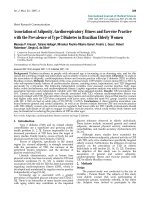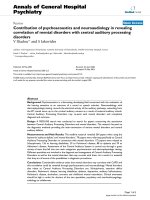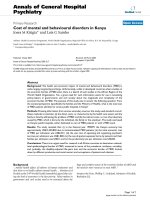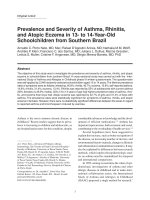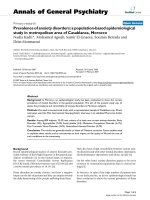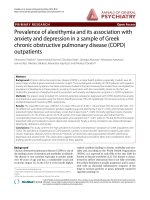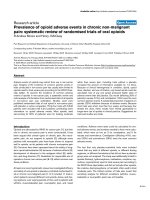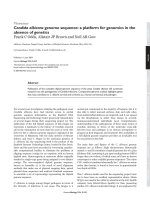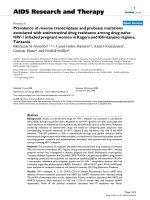Báo cáo y học: "Prevalence of anxiety disorders: a population-based epidemiological study in metropolitan area of Casablanca, Morocco" ppt
Bạn đang xem bản rút gọn của tài liệu. Xem và tải ngay bản đầy đủ của tài liệu tại đây (232.01 KB, 6 trang )
BioMed Central
Page 1 of 6
(page number not for citation purposes)
Annals of General Psychiatry
Open Access
Primary research
Prevalence of anxiety disorders: a population-based epidemiological
study in metropolitan area of Casablanca, Morocco
Nadia Kadri*, Mohamed Agoub, Samir El Gnaoui, Soumia Berrada and
Driss Moussaoui
Address: Ibn Rochd University psychiatric center, Rue Tarik Ibn Ziad, 20000 Casablanca, Morocco
Email: Nadia Kadri* - ; Mohamed Agoub - ; Samir El Gnaoui - ;
Soumia Berrada - ; Driss Moussaoui -
* Corresponding author
Abstract
Background: In Morocco, no epidemiological study has been conducted to show the current
prevalence of mental disorders in the general population. The aim of the present study was to
assess the prevalence and comorbidity of anxiety disorders in Moroccan subjects.
Methods: We used cross-sectional study, with a representative sample of Casablanca city. Direct
interviews used the Mini International Neurpsychiatric Interview in its validated Moroccan Arabic
version
Results: Among 800 subjects, 25.5% met criteria of at least one current anxiety disorder: Panic
Disorder (2%), Agoraphobia (7.6%) Social phobia (3.4), Obsessive Compulsive Disorder (6.1%),
Post Traumatic Stress Disorder (3.4%), Generalized Anxiety Disorder (4.3%)
Conclusion: The results are generally similar to those of Western countries. Future studies need
to replicate these results and to concentrate on their impact on the quality of life and the cost of
such conditions in the community.
Background
Recent epidemiological studies of anxiety disorders pro-
vided evidence of their high frequency in the general pop-
ulation worldwide [1]. In the United States of America,
the recent National Comorbidity Survey Replication
(NCS-R) found a lifetime prevalence rate of 28.8% [2] and
a twelve-month prevalence of 18.1% [3].
These disorders are mostly chronic, and have a negative
impact on the life of patients and they can impair severely
the daily functioning of the people suffering from them.
They also have a high comorbidity between various anxi-
ety disorders and with other mental disorders: depression,
alcohol/substance dependence and abuse, suicide [4].
On the other hand, anxiety disorders appear to be more
common in community populations than in clinical set-
tings [5].
In Morocco, in spite of the high number of patients seen
in our daily practice, so far no epidemiological study has
been conducted to show the current prevalence of these
disorders.
Published: 10 February 2007
Annals of General Psychiatry 2007, 6:6 doi:10.1186/1744-859X-6-6
Received: 10 October 2006
Accepted: 10 February 2007
This article is available from: />© 2007 Kadri et al; licensee BioMed Central Ltd.
This is an Open Access article distributed under the terms of the Creative Commons Attribution License ( />),
which permits unrestricted use, distribution, and reproduction in any medium, provided the original work is properly cited.
Annals of General Psychiatry 2007, 6:6 />Page 2 of 6
(page number not for citation purposes)
The objectives of the current study were to obtain:
- Data on prevalence of anxiety disorders in Moroccan
subjects residing in metropolitan area of Casablanca,
Morocco, in a population-based study.
- Prevalence and nature of comorbidity of these disorders
with other mental disorders.
Methods
The study was cross-sectional one. Men and women, 15
years old or above, were randomly selected using system-
atic sampling from eight prefectorats of Casablanca,
Morocco. The sample was stratified according the gender
and the prefectorats. Streets, blocks and then households
were randomly selected. For each chosen family one
member was randomly selected. The interviews took
place, in the houses of the interviewers "face to face". It
was stated from the beginning that in case of refusal the
person will not be replaced.
For the sampling the authors used the most recent
national census (1994). Sample size was calculated
assuming in the population prevalence of these disorders
is 20.1% (ECA study) with 4% variability. The calculated
sample size at 99% confidence level was 666.
The study protocol and questionnaires were reviewed and
approved by ethics committee, faculty of Medicine, Uni-
versity of Casablanca.
Participants gave their verbal informed consent before
entering in the study.
The standardized instrument which used was the Mini
International Neuro-psychiatric Interview (M.I.N.I) in its
validated Moroccan Arabic language [6] according to the
definitions and criteria of DSM IV [7]. Definition of cur-
rent prevalence was one month for panic disorder, agora-
phobia, social anxiety, obsessive compulsive disorder and
post traumatic stress disorder and 6 months for general-
ized anxiety disorder. Used MINI explores life time preva-
lence only for panic disorder and agoraphobia.
A questionnaire available from the authors inquiring
about socio-demographic data was also used.
Qualified and trained medical doctors assisted in filling
up the questionnaires. The training consisted on five the-
oretical sessions on anxiety disorders according DSMIV
criteria and MINI (two hours each), then Four sessions on
inter rater reliability test.
The pilot study was conducted in 20 subjects aiming
adapting the questionnaire and identifying the difficulties
on the field.
Data analysis was performed on PC microcomputer using
Epi info in its sixth version.
Statistical analysis
This study was a descriptive one. The data were analysed
using the 6
th
version of the Epi Info software (CDC
Atlanta). Statistical methods used univariate analysis;
authors described sociodemographic characteristics and
contingency tables of each disorder. Analysis of variance
(ANOVA) and t test were used for group comparisons.
Chi-square and Fisher's exact test were used for analysis of
categorical data. Level of significance was set at 0.05 for all
analysis.
Results
Out of 874 approached people, 800 had completed the
files; 400 men and 400 women. These 74 people refused
to participate to the study. The reported causes were lack
of time, no interest about the study and no specified
cause.
Demography and habits
The mean age of the population was 32.2 years (SD =
12.8), ranging from 15 to 80 years. Single people repre-
sented 58% of the population; 35.4% of them were mar-
ried.
The level of unemployment was 24.1%; 41.5% had a pro-
fessional activity. The remaining people were students or
housewives.
Concerning the level of education, 15.02% had no educa-
tion, 15.8% had a primary school level (1–5 years), 52.6%
had 6 to 13 years of education and 15.3% had a university
level.
For the monthly income (1US Dollar is equivalent to
about 10 Dh), 18% had less than 1000 Dh per month,
36.4% had 1000–2000 Dh, 33.5% had 2000–5000 Dh,
9.1% had 5000–10000 Dh and 3% had more than 10.000
Dh per month.
For alcohol and substance use/dependence, 20.4% were
current tobacco users and 13.3% were dependent. 3.9%
were cannabis users and 1.8% were dependent. 5.1% were
alcohol users and 2.3% were dependent.
A) Panic Disorder (PD)
The lifetime prevalence of the Panic Disorder was 2.3%;
meanwhile the current prevalence was 2%. This current
PD was associated to agoraphobia in 56.3% (n = 9), and
Annals of General Psychiatry 2007, 6:6 />Page 3 of 6
(page number not for citation purposes)
without agoraphobia in 43.7% (n = 7). Limited symp-
toms of current panic disorders were found in 0.9% of
cases (n = 7).
The epidemiological characteristics of the people with
Current panic Disorder were as follows: female in 87.5%
of cases (n = 14), the mean age was 29.4 years (SD = 10.9),
with 62.5% of single and age of onset of 21.8 years (SD =
6.9). Comorbidity with social phobia was shown in 25%
of cases, with specific phobia in 50%, with obsessive com-
pulsive disorder in 37.5%, with PTSD in 18.8%, and with
Major depressive Disorder in 18.8%.
B) Agoraphobia
For the agoraphobia, the lifetime prevalence was 8.4%.
The current one was 7.6%, with association to panic dis-
order in 14.7%. In 1.6% this agoraphobia had antecedent
of PD.
The epidemiological characteristics of people with current
Agoraphobia were as follows: female in 90.2% (n = 50) of
cases, with a mean age of 30.5 years (SD = 12.9) [15–60
years]. Marital status was shared between single (57.4%)
and Married (34.4%) ones, unemployed people in 70.5%
of cases. Age of onset was 18.5 years (SD = 12.3) and
comorbidity was seen with Social phobia (19.7%), Spe-
cific phobia (60.7%), PTSD (9.8%), OCD (34.4%), and
current major depressive disorder (MDD) in 16.4%
C) Social phobia
In this sample, 3.4% reached the full criteria of social pho-
bia. Most of them were female 82.8% (n = 24). The mean
age was 30.5 years (SD = 12.1), 72.4% of then were single,
65.5% had no professional activity. The age of onset was
15.1 years (SD = 5.8). This disorder was comorbide to: a
current MDD in 20.7%, Panic disorder in 13.8%, Agora-
phobia in 41.4%, Specific Phobia in 55.2%, OCD in
34.5%, PTSD in 13.8%, and dependence to nicotine in
10.3%, to alcohol in 3.4%, to Substance in 6.9%
Lifetime prevalence was not explored because the MINI
life time does not inquire about it
D) Obsessive Compulsive Disorder
The prevalence of OCD was 6.1%. Most of the people
were female 93.8%. The mean Age was 33.7 years (SD =
12.2), 45.8% of them were single and 41.7% married,
64.6% had no professional activity, and the age of onset
was 25.4 years (SD = 11.8). In this sample, 29% had
obsessions and compulsions, 20.8% reported obsessions
Table 1: Characteristics of the study sample
N%
Gender
Male 400 50
Age (years)
15–29 385 48.1
30–44 274 34.2
45–59 114 14.2
≥ 60 27 3.4
Marital status
Single 464 58.0
Married 283 35.3
Divorced 26 3.2
Widowed 27 3.4
Educational level
Illiterates 121 15.2
Primary school 131 16.3
Secondary school 425 53.1
Graduated 123 15.3
Profession
Remunerated Employment 332 41.5
Unemployed 68 58.5
Prevalence
Panic Disorder 18 2.3
Agoraphobia 61 7.6
Social Phobia 29 3.6
Specific Phobia 114 14.3
Obsessive-compulsive Disorder 49 6.1
Post-traumatic-stress Disorder 27 3.4
Generalized Anxiety Disorder 34 4.3
Annals of General Psychiatry 2007, 6:6 />Page 4 of 6
(page number not for citation purposes)
only and 50% reported Compulsions only. The most fre-
quent Types of obsessions were religious, contamination
and aggressive ones. The most commonly occurring com-
pulsions included cleaning and washing, checking and
repeating compulsions.
Comorbidity was seen with: Panic disorder in 12.5%,
Agoraphobia in 43.8%, Social Phobia in 20.8%, Specific
Phobia in 64.6%, PTSD in 8.3%, current MDD in 16.7%
and dependence of nicotine in 2.1%
E) Post Traumatic Stress Disorder
In this sample 12.1% reported have been exposed to trau-
matic events. These events were mostly drowning, fire,
traffic accident and rape. Meanwhile, the prevalence of
PTSD was 3.4 %. Third of the sample (66.6%) was female
with a mean age of 34.1 years (SD = 13.1), 48.1% were
single and 33.3% married, 51.9% had no professional
activity, the mean Age of onset was 26.6 years (SD = 12.2).
This disorder was comorbid with: Panic Disorder in
11.1%, Agoraphobia in 22.2%, Social Phobia in 14.8%,
Specific Phobia in 33.3%, OCD in 14.8%, current MDD
in 7.4%, Dependence of nicotine in 18.5% and alcohol
abuse in 3.7%
F) Generalized Anxiety Disorder
The prevalence of GAD was 4.3%. In 91.1% people suffer-
ing from it were female, the mean age was 35.1 years (SD
= 13.1), 43.5% were single, 40.2% married and 67.4%
had no professional activity.
Discussion
This study is the first one conducted in Moroccan and
Maghrebian population in community sample exploring
the prevalence of anxiety disorders, and it's the first time
we have data in this field which are, in general in accord-
ance with the literature except for the prevalence of Obses-
sive compulsive disorders which was higher in this sample
with higher prevalence among women.
Among 800 subjects, 25.5% met criteria of at least one
current anxiety disorder: Panic Disorder (2.3%), Agora-
phobia (7.6%) Social phobia (3.4), Obsessive Compul-
sive Disorder (6.1%), Post Traumatic Stress Disorder
(3.4%), Generalized Anxiety Disorder (4.3%). We found
a high Comorbidity between anxiety disorders and major
depressive disorder.
In this study the current prevalence of anxiety disorder
was 25.5% which is in accordance with the literature
[3,8]. However The European Study of the Epidemiology
of Mental Disorders projects found a 12 month preva-
lence of any anxiety disorder 6.4% which is lower than
previous studies and the current one [9]. In Arab region,
Okasha and Ashour [10] found the same socio-demo-
graphic pattern than the current study with higher risk for
young women and single people to suffer from anxiety
disorders.
According to literature, lifetime prevalence of PD was
2.3% and the current one was 2% with a higher preva-
lence for women, younger and single subjects and a high
comorbidity with other anxiety disorders and major
depressive disorders [11-14].
It was associated to agoraphobia in about a half of cases.
During recent years, several epidemiological studies con-
ducted around the world determined the relative consist-
ency of the prevalence of panic disorder in the
community. The annual prevalence is about 1% [11], and
the lifetime prevalence has been found to range between
1.4% and 3.5% [11-13], with lower rates in some Asian
countries. Rates were found higher in women than in
men, in younger, and widowed, separated and divorced
subjects. Comorbidity of panic disorder with other anxi-
ety disorders and affective disorders has also been consist-
ently reported in these studies.
In Arab countries, Weissman et al. [14] in the Cross-
national epidemiology study of panic disorder in 10
countries, including over 40000 subjects, found that life-
time prevalence rates for panic disorder ranged from 1.4%
to 2.9%. Mean age at first onset was usually in early to
middle adulthood. The rates were higher in females than
Table 2: Comorbidities of anxiety disorders
PD Agoraphobia Social phobia OCD PTSD
PD - 14.713.812.511.1
Agoraphobia 56.3 - 41.4 43.8 22.2
Social phobia 25 19.7 - 20.8 14.8
OCD37.534.434.5- 14.8
PTSD 18.8 9.8 13.8 8.3 -
MDD18.816.420.716.77.4
PD: panic disorder, OCD: obsessive compulsive disorder, PTSD: post-traumatic disorder, MDD: major depressive disorder
Annals of General Psychiatry 2007, 6:6 />Page 5 of 6
(page number not for citation purposes)
in male subjects in all countries. Panic disorder was asso-
ciated with an increased risk of agoraphobia and major
depression in all countries.
On the other hand, Weissman et al. [14] found a predom-
inance of females in the one-month and 6-month preva-
lence rates of panic disorder in most countries. A
comorbidity pattern with agoraphobia is observed in
29.5%-58.2% of subject with panic disorder [11-13].
Current prevalence of social phobia was 3.4%, predomi-
nantly in women, single, and middle-aged people. Mean
age was older than for other anxiety disorders, and the age
of onset was in the adolescence. A high comorbidity was
seen with MDD, other anxiety disorders and alcohol and
substance dependency [11,13,15,16]. In the literature,
various epidemiological studies have indicated social anx-
iety disorder is a frequent condition in the community.
The lifetime prevalence rates ranges from 2% to 4% for the
most severe forms and up to 10% or even 15% meanwhile
the National comorbidity survey (NCS) found 12 months
rates of 7.9% [11,13,16].
In our study, the lifetime prevalence of OCD was 6.1%.
Female gender was predominant. Both obsessions and
compulsions were seen in about one third of cases. Com-
pulsions only were found in half of them. In ECA study,
1-month prevalence was 1.3%, 6-month prevalence 1.5%
and lifetime prevalence was 2.5% [17]. We have no expla-
nation for this higher lifetime prevalence of OCD as well
as for the predominance of female subjects, to be con-
firmed by others studies. But we can hypothesis that in
Morocco the religious obsessions are more frequent in
Morocco following the example of cultures with more
religious connotation such as Turkey, Israel, Bahrain
Egypt and Saudi Arabia. On the other hand, biological fac-
tor might also be an explanation
A study conducted by Okasha et al. [18] found that the
prevalence rate of OCD, in a psychiatric outpatient Egyp-
tian study was 2.3%, meanwhile the same authors found
a highest prevalence of obsessive compulsive symptoms
(62.4%) in a sample of Egyptian psychiatric patients [19].
These two studies were the only studies in the region
found to be compared to our, however they were con-
ducted in clinic settings no in community.
In our study, 12.1% of the sample was exposed to trau-
matic events at least once during their lives, 3.4% of them
satisfied PTSD diagnosis. Female gender was predomi-
nant, and comorbidity with all types of anxiety and with
depression was relatively high. This Estimates of the life-
time prevalence of PTSD from surveys of the general adult
population ranged from 1% to 12.3% [20,21].
Estimates of the lifetime prevalence of PTSD from surveys
of the general adult population ranged from 1% to 12.3%.
Using data from two sites in the Epidemiologic Catch-
ment Area program, Helzer et al. [20] reported a lifetime
prevalence of 1%.
Evidence suggests that exposure to potentially traumatic
events may be more common that once thought, and that
risk factors for PTSD include personal and biographical
histories at the time of exposure to the extreme event,
characteristics of the event itself, and characteristics of the
post-exposure environment. For example, Resnick et al.
[21] examined PTSD prevalence rates associated with dif-
ferent types of extreme events in a nationally representa-
tive community sample of women. The overall prevalence
was 12.3% lifetime. This prevalence varied by type of trau-
matic event. Women who reported interpersonal violence
were more likely to meet criteria for lifetime (25.8%) and
current (9.4%) PTSD than women who reported other
stressors only.
The current prevalence of GAD was 4.3% with predomi-
nance of female, without professional activity. For the
NCS, the current prevalence was 1.6 and a 12-month prev-
alence was of 3.1 %, and GAD was more common in
women, and had a very high lifetime comorbidity of 90%
with a wide spectrum of other psychiatric disorders [22].
We noted some limitations of the present study:
- Small size of the sample which limited only in the city of
Casablanca. The next step is the explore the anxiety disor-
ders in a National randomised sample
- Socio-cultural factors might be explanation for some dif-
ferences such as the prevalence of OCD;
Conclusion
For the first time in Morocco, systematic epidemiological
data on anxiety disorders are available. The results are gen-
erally similar to those of Western countries. Future studies
need to concentrate on their impact on the quality of life
and the cost of such conditions in the community.
Competing interests
The author(s) declare that they have no competing inter-
ests.
Authors' contributions
NK and AM conceived and coordinated the study. NK,
MA, SE and SB designed and performed questionnaire
and carried out the data collection. NK, MA and DM
drafted the manuscript. All authors read and approved the
final manuscript.
Publish with BioMed Central and every
scientist can read your work free of charge
"BioMed Central will be the most significant development for
disseminating the results of biomedical research in our lifetime."
Sir Paul Nurse, Cancer Research UK
Your research papers will be:
available free of charge to the entire biomedical community
peer reviewed and published immediately upon acceptance
cited in PubMed and archived on PubMed Central
yours — you keep the copyright
Submit your manuscript here:
/>BioMedcentral
Annals of General Psychiatry 2007, 6:6 />Page 6 of 6
(page number not for citation purposes)
References
1. Lepine JP: The epidemiology of anxiety disorders: prevalence
and societal costs. J Clin Psychiatry 2002, 63(Suppl 14):4-8.
2. Kessler RC, Berglund P, Demler O, Jin R, Merikangas KR, Walters EE:
Lifetime Prevalence and Age-of-Onset Distributions of
DSM-IV Disorders in the National Comorbidity Survey Rep-
lication. Arch Gen Psychiatry 2005, 62:593-602.
3. Kessler RC, Chiu WT, Demler O, Walters EE: Prevalence, Sever-
ity, and Comorbidity of 12-Month DSM-IV Disorders in the
National Comorbidity Survey Replication. Arch Gen Psychiatry
2005, 62:617-627.
4. Kessler RC, Nelson CB, McGonagle KA, Liu J, Swartz M, Blazer DG:
Comorbidity of DSM-III-R Major depressive disorder in the
General Population: result from the US National Comorbid-
ity Survey. Br J Psychiatry suppl 1996, 30:17-30.
5. Karno M, Golding JM, Sorenson SB, Burnam MA: The Epidemiol-
ogy of obsessive compulsive disorder in five US Communi-
ties. Arch Gen Psychiatry 1988, 45:1094-1099.
6. Kadri N, Agoub M, EL Gnaoui S, Mchichi Alami Kh, Hergueta T, Mous-
saoui D: Moroccan Colloquial Arabic version of the Mini-
International Neuropsychiatric Interview (M.I.N.I): Qualita-
tive and Quantitative validation. Eur Psychiatry 2005,
20:193-195.
7. American psychiatric Association: Diagnostic and Statistical manual of
mental Disorders 4th edition. Washington, DC, American psychiatric
Association; 1994.
8. Weissman MM, Bland RC, Canino GJ, Faravelli C, Greenwald S, Hwu
HG, Joyce PR, Karam EG, Lee CK, Lellouch J, Lepine JP, Newman SC,
Oakley Browne MA, Rubio Stipec M, Wells JE, Wickramaratne PJ,
Wittchen HU, Yeh EK: The cross-national epidemiology of
panic disorder. Arch Gen Psychiatry 1997, 54:305-309.
9. Alonso J, Angermeyer MC, Bernert S, Bruffaerts R, Brugha TS, Bryson
H, de Girolamo G, Graaf R, Demyttenaere K, Gasquet I, Haro JM,
Katz SJ, Kessler RC, Kovess V, Lepine JP, Ormel J, Polidori G, Russo
LJ, Vilagut G, Almansa J, Arbabzadeh-Bouchez S, Autonell J, Bernal M,
Buist-Bouwman MA, Codony M, Domingo-Salvany A, Ferrer M, Joo
SS, Martinez-Alonso M, Matschinger H, Mazzi F, Morgan Z, Morosini
P, Palacin C, Romera B, Taub N, Vollebergh WA, ESEMeD/MHEDEA
2000 Investigators, European Study of the Epidemiology of Mental
Disorders (ESEMeD) Project: Prevalence of mental disorders in
Europe: results from the European of epidemiology of men-
tal disorders (ESEMeD) project. Acta Psychiatr Scand suppl 2004,
420:21-27.
10. Okasha A, Ashour A: Psycho-Demographic Study of Anxiety in
Egypt: The PSE in its Arabic Version. Br J Psychiatry 1981,
139:70-73.
11. Eaton WW, Drymon A: Weissman MM. Panic and phobias. In
Psychiatric disorders in America: The Epidemiologic Catchment Area Study
Edited by: Robins LN, Regier DA. New York: The free press; 1991.
12. Eaton WW, Kessler RC, Wittchen HU, Magee WJ: Panic and panic
disorder in the United States. Am J Psychiatry 1994, 151:413-420.
13. Bland RC, Orn H, Newman SC: Lifetime prevalence of psychiat-
ric disorders in Edmonton. Acta Psychiatr Scand suppl 1988,
338:24-32.
14. Weissman MM, Canino GJ, Greenwald S, Joyce PR, Karam EG, Lee
CK, Rubio Stipec M, Wells JE, Wickramaratne PJ, Wittchen HU: Cur-
rent rates and symptom profiles of panic disorder in six
cross-national studies. Clin Neuropharmacol suppl 1995, 18:1-6.
15. Schneider FR, Johnson J, Horning CD, Liebowitz MR: Social phobia,
comorbidity and mortality in an epidemiological sample.
Arch Gen psychiatry 1992, 49:282-288.
16. Kessler Rc, Mc Gonagle KA, zhao S, Nelson CB, Hughes M, Eshleman
S, Wittchen Hu, Kendler KS: Lifetime and 12-month prevalence
of DSM IIIR psychiatric disorders in the United States,
Results from the National Comorbidity Survey. Arch Gen Psy-
chiatry 1994, 51:8-19.
17. Regier DA, Boyd JH, Burke JD Jr, Rae DS, Myers JK, Kramer M, Rob-
ins LN, George LK, Karno M, Locke BZ: One month prevalence
of mental disorders in United states, based on five Epidemi-
ologic Catchment Area sites. Arch Gen Psychiatry 1988,
45:977-986.
18. Okasha A, Seif El Dawla A, Youssef I: Obsessive Compulsive dis-
order: A transcultural comparison. Italian Journal of Psychiatry
and behavioral Sciences 1995, 3:109-115.
19. Okasha A, Lotaief , Ashour AM, el Mahalawy N, Seif el Dawla A, el-
Kholy G: The prevalence of obsessive compulsive symptoms
in a sample of Egyptian psychiatric patients. Encephale 2000,
26:1-10.
20. Helzer JE, Robins LN, Mc Evory L: Post traumatic stress disorder
in the general population: finding of the Epidemiologic catch-
ment area survey.
N Engl J Med 1987, 317:1630-1634.
21. Resnick HS, Kilpatrick DG, Dansky BS, Saunders BE, Best CL: prev-
alence of civilian trauma and posttraumatic stress disorder
in a representative sample of women. J Consult Clin Psychol 1993,
61:948-991.
22. Wittchen HU, Zhao S, Kessler RC, Eaton WW: DSM-III-R gener-
alized anxiety disorder in the National Comorbidity Survey.
Arch Gen Psychiatry 1994, 51:355-364.
